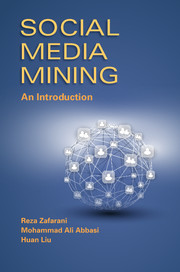7 - Information Diffusion in Social Media
from Part II - Communities and Interactions
Published online by Cambridge University Press: 05 July 2014
Summary
In February 2013, during the third quarter of Super Bowl XLVII, a power outage stopped the game for 34 minutes. Oreo, a sandwich cookie company, tweeted during the outage: “Power out? No Problem, You can still dunk it in the dark.” The tweet caught on almost immediately, reaching nearly 15,000 retweets and 20,000 likes on Facebook in less than two days. A simple tweet diffused into a large population of individuals. It helped the company gain fame with minimum cost in an environment where companies spent as much as $4 million to run a 30-second ad. This is an example of information diffusion.
Information diffusion is a field encompassing techniques from a plethora of sciences. In this chapter, we discuss methods from fields such as sociology, epidemiology, and ethnography, which can help social media mining. Our focus is on techniques that can model information diffusion.
Societies provide means for individuals to exchange information through various channels. For instance, people share knowledge with their immediate network (friends) or broadcast it via public media (TV, newspapers, etc.) throughout the society. Given this flow of information, different research fields have disparate views of what is an information diffusion process. We define information diffusion as the process by which a piece of information (knowledge) is spread and reaches individuals through interactions.
- Type
- Chapter
- Information
- Social Media MiningAn Introduction, pp. 179 - 214Publisher: Cambridge University PressPrint publication year: 2014
- 4
- Cited by



